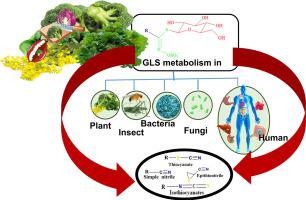Biotechnology Advances ( IF 12.1 ) Pub Date : 2021-06-06 , DOI: 10.1016/j.biotechadv.2021.107784 Zeinab T Shakour 1 , Naglaa G Shehab 2 , Ahmed S Gomaa 3 , Ludger A Wessjohann 4 , Mohamed A Farag 5

|
Glucosinolate-producing plants have long been recognized for both their distinctive benefits to human nutrition and their resistance traits against pathogens and herbivores. Despite the accumulation of glucosinolates (GLS) in plants is associated with their resistance to various biotic and abiotic stresses, the defensive and biological activities of GLS are commonly conveyed by their metabolic products. In view of this, metabolism is considered the driving factor upon the interactions of GLS-producing plants with other organisms, also influenced by plant and plant attacking or digesting organism characteristics. Several microbial pathogens and insects have evolved the capacity to detoxify GLS-hydrolysis products or inhibit their formation via different means, highlighting the relevance of their metabolic abilities for the plants' defense system activation and target organism detoxification. Strikingly, some bacteria, fungi and insects can likewise produce their own myrosinase (MYR)-like enzymes in one of the most important adaptation strategies against the GLS-MYR plant defense system. Knowledge of GLS metabolic pathways in herbivores and pathogens can impact plant protection efforts and may be harnessed upon for genetically modified plants that are more resistant to predators. In humans, the interest in the implementation of GLS in diets for the prevention of chronic diseases has grown substantially. However, the efficiency of such approaches is dependent on GLS bioavailability and metabolism, which largely involves the human gut microbiome.
Among GLS-hydrolytic products, isothiocyanates (ITC) have shown exceptional properties as chemical plant defense agents against herbivores and pathogens, along with their health-promoting benefits in humans, at least if consumed in reasonable amounts. Deciphering GLS metabolic pathways provides critical information for catalyzing all types of GLS towards the generation of ITCs as the biologically most active metabolites. This review provides an overview on contrasting metabolic pathways in plants, bacteria, fungi, insects and humans towards GLS activation or detoxification. Further, suggestions for the preparation of GLS containing plants with improved health benefits are presented.
中文翻译:

代谢和生物转化对膳食硫代葡萄糖苷的影响、它们在不同生物体中的生物利用度、分解代谢和生物学效应
长期以来,产生硫代葡萄糖苷的植物因其对人类营养的独特益处及其对病原体和食草动物的抗性特征而得到认可。尽管植物中硫代葡萄糖苷 (GLS) 的积累与其对各种生物和非生物胁迫的抵抗力有关,但 GLS 的防御和生物活性通常由其代谢产物传递。鉴于此,代谢被认为是产生 GLS 的植物与其他生物相互作用的驱动因素,也受到植物和植物攻击或消化生物特征的影响。几种微生物病原体和昆虫已经进化出解毒 GLS 水解产物或通过以下途径抑制其形成的能力不同的手段,突出了它们的代谢能力与植物防御系统激活和目标生物解毒的相关性。引人注目的是,一些细菌、真菌和昆虫同样可以产生它们自己的类黑芥子酶 (MYR),这是针对 GLS-MYR 植物防御系统的最重要的适应策略之一。了解食草动物和病原体中的 GLS 代谢途径会影响植物保护工作,并可用于对捕食者更具抵抗力的转基因植物。在人类中,对在饮食中实施 GLS 以预防慢性疾病的兴趣已大大增加。然而,这些方法的效率取决于 GLS 的生物利用度和代谢,这主要涉及人类肠道微生物组。
在 GLS 水解产品中,异硫氰酸酯 (ITC) 已显示出作为植物化学防御剂的特殊特性,可抵御食草动物和病原体,以及它们对人类健康的益处,至少在合理数量的情况下是这样。破译 GLS 代谢途径为催化所有类型的 GLS 生成 ITC 作为生物学上最活跃的代谢物提供了关键信息。本综述概述了植物、细菌、真菌、昆虫和人类对 GLS 激活或解毒的代谢途径的对比。此外,还提出了制备具有改善健康益处的含有 GLS 的植物的建议。











































 京公网安备 11010802027423号
京公网安备 11010802027423号